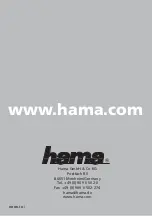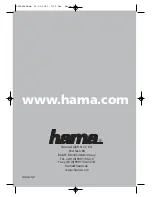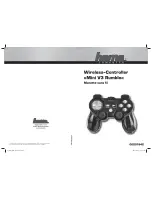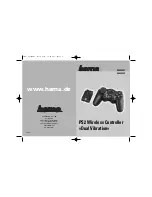
CTR25
2
For slow temperature changes i. e. room control CTR25 will act as a P
controller with a proportional band of 1.5K.
External control signal
CTR25 can also be run against a 0 - 10V DC control signal from another
controller.
Remove the wire strap between terminals 7 and 9 and connect the control
signal as shown in figure 7.
0-10V DC in
Signal neutral
8 9
7
Remove
wire
Figure 7: Wiring of external control signal
0V input signal will give 0% output and 10V input will give 100% output.
Minimum and maximum limit functions are not active when using an
external control signal.
Start-up and fault finding
1. Check that all wiring is correct and that the sensor selector switches
are in the correct position.
2. Measure the resistance between terminals L1out - L2out, L1out -
L3out and L2out -L3out:
At 230V phase-phase voltage: 10.6
Ω
<R<66.4
Ω
.
At 400V phase-phase voltage: 18.4
Ω
<R<115
Ω
.
3. Connect supply voltage and turn the setpoint knob to the maximum
value. The LED on the CTR25 should be continuously on or pulse
on/off with longer and longer ontime and eventually be continu-
ously on.Turn the setpoint to the minimum value. The LED should
be continuously off or pulse on/off with longer and longer offtime
and eventually be continuously off. At a certain position (within the
proportional band) the LED will pulse On-Off as the CTR25 pulses
current to the heater. The pulse cycle period is approx. 6 -60 sec-
onds depending on the setting of the CT-potentiometer. Check with a
clamp-on ammeter that current is flowing to the heater.
Something wrong?
1. Remove wiring to external sensor (and setpoint if any). Measure the
resistance of the sensor and setpoint separately
.
The potentiometer
resistance varies 0- 5k
Ω
between the lower and upper end-point.
The sensor resistance varies between 10k
Ω
and 15k
Ω
between the
upper and lower ends of the sensor temperature range. I.e. a STCC-
NTC15-01 has 15k
Ω
at 0°C and 10k
Ω
at 30°C. The resistance
changes by 167
Ω
/°C.
2. Leave the sensor terminals unconnected. Set all switches in the
downward position. Switch the voltage on.
CTR25 should give full uninterrupted power and the LED should
be lit. Check with a clamp-on ammeter that current is flowing to
the heater.
If the LED is not lit and no current is flowing: Check that you
have power on terminals L1in, L2in and L3in and recheck the
positions of the sensor selector switches. If OK the CTR25 is
probably faulty.
If the LED lights up but no current is flowing: Recheck the heater
resistance as above. If OK the CTR25 is probably faulty.
3. Shut off power and short-circuit the sensor input 1 and 4. Switch
on power again.
CTR25 should not give out any power at all and the LED should
be extinguished. Check with a clamp-on ammeter that no current
is flowing to the heater.
If the LED is extinguished but current is flowing to the heater the
CTR25 is faulty.
If the LED is lit, recheck the shorting of the sensor input termi-
nals. If OK the CTR25 is faulty.
4. If everything is OK this far the CTR25 and the sensor/setpoint
are OK. Shut off power, remove the wire strap from the the
sensor input terminals and reconnect external sensor(s) (and
setpoint if any).Set the switches to their correct positions. Con-
nect power.
Low Voltage Directive (LVD) standards
This product conforms to the requirements of the European Low Volt-
age Directive (LVD) 2006/95/EC through product standard EN 60730-
1.
EMC emissions & immunity standards
This product conforms to the requirements of the EMC Direc-
tive 2004/108/EC through product standards EN 61000-6-1 and
EN 61000-6-3.
RoHS
This product conforms with the Directive 2011/65/EU of the European
Parliament and of the Council.
Contact
AB Industrietechnik Srl
Via Julius Durst, 70 - 39042 Bressanone (BZ) - Italy
Tel. +39 0472/830626 - Fax +39 0472/831840
www.industrietechnik.it - [email protected]
Limiting sensor
Terminals 5 and 6. Low voltage. Not polarity sensitive.
When running room temperature control the supply air temperature
can be limited to a maximum and/or a minimum. The limiting sensor is
placed in the supply air duct after the heater.
Choice of function is made using switches 2 and 3. Choice of limiting
temperatures is made on potentiometers Min and Max.
STCC-NTC15-02
5 6
Figure 6: Wiring of limiting sensor
N.B.
As limiting sensor STCC-NTC15-02 must be used.
Settings
Potentiometers
Setp. Setpoint 0 - 30°C.
Min
Minimum limit for supply air temperature when running room
temperature control.
Max
Maximum limit for supply air temperature when running room
temperature control.
CT
Cycle time. 6 - 60 seconds.
Switches
1
Down = External setpoint in use.
Up = Internal setpoint in use.
2
Down = Minimum limit not active.
Up = Minimum limit active.
3
Down = Maximum limit not active.
Up = Maximum limit active.
N.B.
Minimum and maximum limiting functions may be used
separately or at the same time.
Control principle
CTR25 pulses the full load On - Off. CTR25 adjusts the mean power
output to the prevailing power demand by proportionally adjusting the
ratio between On-time and Off-time. The cycle time (=the sum of On-
time and Off-time) is adjustable 0 - 60 seconds.
CTR25 has zero phase-angle firing to eliminate RFI.
CTR25 automatically adapts its control mode to suit the dynamics of
the control object .
For rapid temperature changes i. e. supply air control CTR25 will act
as a PI controller with a proportional band of 20K and a reset time of
6 minutes.


























